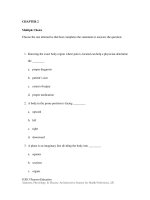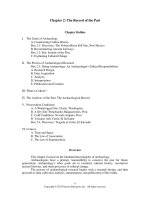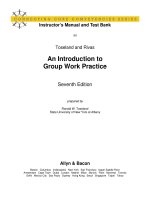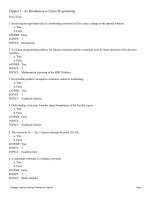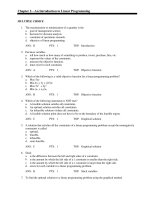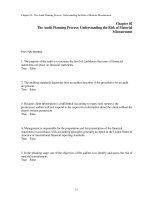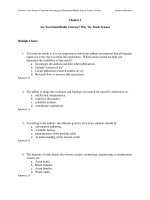Your science classroom becoming an elementary middle school science teacher 1st edition goldston test bank
Bạn đang xem bản rút gọn của tài liệu. Xem và tải ngay bản đầy đủ của tài liệu tại đây (130.96 KB, 6 trang )
Goldston, Your Science Classroom: Becoming an Elementary/Middle School Science Teacher
Instructor Resource
Chapter 2
Are You Scientifically Literate? Why We Teach Science
Multiple Choice
1. You read an article in Soy Joy magazine in which the authors recommend that all humans
ingest soy every day to extend life expectancy. Which action would not help you
determine the credibility of the article?
a. Investigate the authors and their other publications.
b. Google “sources of joy”
c. Locate additional research studies on soy.
d. Research how to increase life expectancy.
Answer: b
2. The ability to judge the evidences and findings of research for oneself is referred to as:
a. intellectual independence.
b. cognitive dissonance.
c. scientific acumen.
d. considerate exploration.
Answer: a
3. According to the authors, the ultimate goal for all science students should be:
a. information gathering.
b. scientific literacy.
c. memorization of the periodic table.
d. an understanding of the natural world.
Answer: b
4. The majority of individuals who choose science, technology, engineering, or mathematics
careers are:
a. Asian males.
b. Black females.
c. Asian females.
d. White males.
Answer: d
Goldston, Your Science Classroom: Becoming an Elementary/Middle School Science Teacher
Instructor Resource
5. Which event prompted an increase in U.S. funding for schools to enhance math and
science?
a. The publication of Charles Darwin’s book On the Origin of Species in 1859
b. The Space Shuttle Challenger disaster in 1986
c. The reauthorization of No Child Left Behind in 2001
d. The Soviet Union’s launch of Sputnik in 1957
Answer: d
6. Which of the following subjects was not part of the traditional core curriculum?
a. Writing
b. Science
c. Reading
d. Arithmetic
Answer: b
7. The National Commission on Excellence in Education recommended that science
students be taught all of the following except:
a. natural selection.
b. the process of science.
c. methods of scientific inquiry.
d. application of science to daily life.
Answer: a
8. What is the name of the massive, long-term reform effort designed to promote scientific
literacy in the U.S. by the year 2061?
a. Halley’s Comet
b. Project 2061
c. TIMSS
d. Educating Americans for the 21st Century
Answer: b
9. What was the greatest national concern while the National Commission on Excellence in
Education was conducting its work?
a. International competitiveness
b. Terrorism
c. Crime
d. Soaring rates of school truancy
Goldston, Your Science Classroom: Becoming an Elementary/Middle School Science Teacher
Instructor Resource
Answer: a
10. All of the following are aspects of the NSES standards except:
a. prescription for a national curriculum.
b. appropriate science content for K-12 science practices.
c. the vision of science for all students.
d. defining scientific literacy.
Answer: a
11. The NSES standards are organized around grade-level bands. Which of the following is
not one of these bands?
a. K-4
b. K-1
c. 5-8
d. 9-12
Answer: b
12. Ideas that describe the often multifaceted relationships among related concepts are called:
a. facts.
b. concepts.
c. principles.
d. notions.
Answer: c
13. The NSES grade-level content strands are designed to promote the _____ of learning
science content.
a. transference
b. scaffolding
c. evolution
d. independence
Answer: b
14. All of the following are listed on the NSES website as an important reason for scientific
literacy except:
a. personal fulfillment and excitement.
b. the need for good judgment regarding shared resources such as air, water, and
forests.
Goldston, Your Science Classroom: Becoming an Elementary/Middle School Science Teacher
Instructor Resource
c. support of higher salaries for science teachers.
d. the increasing need for informed decision making about scientific information.
Answer: c
15. Knowledge that washing dishes with soap and hot water is better in removing grease is an
example of:
a.
b.
c.
d.
scientific literacy.
lunacy.
environmental ignorance.
abstract thinking.
Answer: a
16. Scientifically literate students who do not choose science as a career may still impact the
world by:
a. facilitating support groups for those who are not scientifically literate.
b. participating in an informed way on issues related to science.
c. choosing only scientifically-based reading material.
d. teaching others about the adverse effects of aspartame.
Answer: b
17. Discrete information substantiated through evidence is called a(n):
a. concept.
b. idea.
c. variable.
d. fact.
Answer: d
18. Scientific literacy is not:
a. knowledge and understanding of scientific concepts.
b. processes required for personal decision making and participation in civic and
cultural affairs.
c. reading and believing investigations and scientific reports at face value.
d. using available resources to research information for decision making.
Answer: c
19. The NSES view students as _____ learners who are _____ about the world.
a. gifted; already knowledgeable
Goldston, Your Science Classroom: Becoming an Elementary/Middle School Science Teacher
Instructor Resource
b. active; curious
c. monastic; uninformed
d. blank slate; ignorant
Answer: b
20. The ideas or processes that connect scientific ideas across the disciplines are called:
a. unifying concepts.
b. holistic thoughts.
c. consistent hypotheses.
d. effective criteria.
Answer: a
True or False
1. Benchmarks for Scientific Literacy was created as a national standards document.
False
2. Facts are ideas that describe the multifaceted relationships among concepts.
Answer: False
3. The NSES content strands are identified by grade-level bands.
True
4. A crucial aspect of a theory is that it is constant and unchanging.
Answer: False
5. According to the authors, science is an interactive and social endeavor.
Answer: True
6. Most educators agree that scientific literacy is ideally a short-term, discrete process.
Goldston, Your Science Classroom: Becoming an Elementary/Middle School Science Teacher
Instructor Resource
Answer: False
7. In order to be scientifically literate, it is important that students learn to conform their
ideas to majority opinion.
Answer: False
8. The publication, Science for All Americans, includes grade-level learning standards.
Answer: False
Short Answer and Essay
1. Why is it important to understand how past reform initiatives and policies influence the
state of science education today?
2. Provide an example in which one applies scientific knowledge to a typical daily routine.
3. Define a principle, concept, and fact. Provide an example of each.
4. List and describe the two documents that have been instrumental in moving science
education to where we are today.
5. Describe how the goal of scientific literacy can encourage minority involvement in the
sciences.
